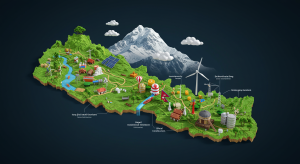Nepal’s 83GW Hydro Explosion: End Power Woes, Dominate Cryptocurrency Mining Future!

Nepal, nestled in the lap of the Himalayas, is home to over 6,000 rivers and streams fed by melting glaciers, offering an unparalleled opportunity in renewable energy. With an estimated hydroelectric potential of 83,000 MW—43,000 MW of which is economically viable—the country has only tapped into about 3,422 MW as of early 2025. This underutilization represents not just wasted potential but a golden chance to pioneer sustainable cryptocurrency mining. As global Bitcoin mining shifts toward green energy, with sustainable sources now powering 52.4% of operations worldwide, Nepal could emerge as a Himalayan hub for eco-friendly crypto ventures. Amid recent political upheavals driven by Gen Z protests, the timing might be ripe for regulatory reforms that unlock this synergy between abundant hydropower and the digital economy.
Nepal’s Untapped Hydroelectric Goldmine
Nepal’s rivers cascade from the world’s highest peaks, providing consistent, year-round water flow ideal for hydropower generation. The government’s Energy Development Roadmap aims to ramp up capacity to 28,500 MW in the coming years, yet current output stands at just over 3,000 MW from hydropower alone. This surplus potential translates to electricity costs as low as $0.02-0.04 per kWh, far below global averages, making it economically attractive for energy-intensive industries.
Climate change adds nuance: Initial glacial melting could boost hydropower by 5.7% by 2030, but long-term risks like erratic monsoons threaten stability. Still, Nepal’s high-altitude locations offer natural cooling, reducing the need for additional infrastructure. Remote micro-hydro sites, scalable across thousands of locations, could power decentralized operations while minimizing environmental impact—provided sustainable practices are prioritized, including environmental impact assessments for stream modifications.
The Allure of Cryptocurrency Mining in a Green Context
Cryptocurrency mining, particularly for Bitcoin, requires immense computational power and electricity, often criticized for its carbon footprint. However, the industry is pivoting: In 2025, renewable energy dominates in top mining nations, with hydropower leading the charge. Nepal’s low-cost, renewable hydro could slash mining expenses by 80-90%, turning unprofitable setups viable while aligning with global sustainability goals.
Imagine micro-hydro plants in rural districts fuelling mining rigs, creating jobs in tech maintenance, engineering, and data analysis. This could address Nepal’s 20.8% youth unemployment, channelling Gen Z’s digital savvy into economic growth. Moreover, excess power—often wasted during off-peak seasons—could be monetized, funding infrastructure and reducing reliance on remittances, which account for 25% of GDP.
Lessons from Global and Regional Pioneers
Nepal isn’t starting from scratch. Neighbouring Bhutan has quietly become a crypto powerhouse, mining Bitcoin with 100% hydropower since 2019. By mid-2025, Bhutan’s state-led operations, partnered with Bitdeer, have amassed $1.3-1.4 billion in BTC, representing nearly 40% of its GDP. Generating 55-75 BTC weekly, Bhutan maintains its carbon-negative status while boosting revenue— a model Nepal could adapt for its own hydro surplus.
El Salvador offers another blueprint, having mined 474 BTC valued at $29-46 million using geothermal energy from volcanoes. As the first nation to adopt Bitcoin as legal tender in 2021, it integrates crypto into remittances and education, with 30% of citizens holding BTC despite volatility challenges. Nepal could similarly leverage hydro-mined crypto for financial inclusion.
In the UAE, Dubai’s Virtual Assets Regulatory Authority (VARA) has licensed over 30 firms, propelling a 42% CAGR in the crypto sector through 2030. Events like CryptoExpo attract global investors, emphasizing sustainability—ripe for partnerships with Nepal’s low-cost energy.
Other nations amplify the trend: Iceland and Norway use geothermal and hydro for 1-1.63% of global hashrate, Canada harnesses Quebec’s cheap hydro, Paraguay monetizes Itaipu dam excess, Ethiopia taps its Renaissance Dam, and Kazakhstan shifts to renewables post-crackdowns. These examples show renewables not only mitigate environmental concerns but drive economic diversification.
| Country | Renewable Source | Key Achievement (2025) | Lesson for Nepal |
| Bhutan | Hydropower | $1.3B in BTC holdings | State-partnered green mining for GDP boost |
| El Salvador | Geothermal | 474 BTC mined | National adoption for remittances |
| UAE/Dubai | Mixed (focus on regulation) | 7% of global transactions | Investor-friendly frameworks |
| Iceland/Norway | Geothermal/Hydro | Cool-climate efficiency | Scalable micro-sites |
| Canada/Paraguay | Hydropower | Regional economic stimulus | Surplus energy monetization |
Political Shifts: Gen Z Protests and Emerging Opportunities
Nepal’s cryptocurrency landscape remains constrained by the Nepal Rastra Bank’s (NRB) outright ban since 2021, prohibiting trading, mining, and storage due to fraud and laundering risks. As of September 2025, no liberalization has occurred, with the NRB exploring a central bank digital currency (CBDC) instead.
However, the Gen Z-led protests that erupted in early September 2025—triggered by a ban on 26 social media platforms, corruption, and inequality—have reshaped the political arena. Violent clashes led to Prime Minister KP Oli’s resignation, Parliament’s dissolution, and army deployment. Now, an interim government coordinates with activists for reforms, echoing Gen Z movements in Asia.
This vacuum could catalyse crypto-friendly policies, tying hydro mining to job creation and anti-corruption transparency via blockchain. Youth demands for economic dignity align perfectly with a “Hydro-Crypto Zone” initiative, attracting investments from UAE funds or Bhutanese partners.
Best geographical regions in Nepal (what to build where and why)
1) Dolakha / Tamakoshi area (Central-East) — near Upper Tamakoshi (largest plant)
Why: Largest operational plant in Nepal (456 MW peaking plant) — strong seasonal generation and peaking capability; existing access roads and grid. Good for modular mining facilities that ramp up in high flow. Wikipedia+1
Good for: medium-scale government + partner pilot; low transmission loss; visible proof-of-concept.
2) Karnali Basin (Upper Karnali / West of country)
Why: Large planned/under-development projects (Upper Karnali, West Seti region) and huge untapped hydro potential in Karnali. Lower population density → easier land/expansion.
Good for: large-scale mining clusters (if transmission to load centers/export is solved).
3) Gandaki / Marsyangdi & Trishuli corridor (central hills)
Why: Established hydropower plants, proximity to Kathmandu and major roads. Easier access to skilled labor and support services.
Good for: smaller, higher-availability operations that can also serve as data center clusters / compute parks.
4) Eastern Koshi / Arun region
Why: Several proposed large projects; potential for new builds with integrated data parks. Good seasonal surplus profile from monsoon-fed rivers.
Good for: mixed use (mining during surplus, grid support or industrial loads otherwise).
5) Southern Transmission Hubs (Butwal/Parwanipur / Dhalkebar area)
Why: These are transmission/export nodes near India connection points. If surplus would otherwise be exported cheaply, colocating flexible demand (mining) near export interconnections lets Nepal capture higher value domestically.
Challenges and the Path to Sustainable Implementation
Hurdles abound: Regulatory uncertainty, environmental permitting for hydro sites, and crypto volatility demand caution. Tax implications, AML compliance, and minimal carbon footprints must be addressed to avoid pitfalls seen elsewhere.
A phased approach—piloting small-scale mining in remote areas, forging international partnerships, and advocating for NRB reforms—could mitigate risks. Tools like water flow calculators and altitude-specific equipment would ensure viability.
Final Thoughts: From Rivers to Riches
Nepal stands at a crossroads where Himalayan waters could power a digital revolution. By harnessing hydroelectric potential for sustainable crypto mining, the nation can create thousands of jobs, monetize energy surplus, and position itself as Asia’s green crypto haven. As Gen Z’s voice echoes in the halls of power, the post-protest era offers a unique window for bold innovation. Policymakers, entrepreneurs, and investors: The rivers are flowing—it’s time to plug in.

Leave a Reply